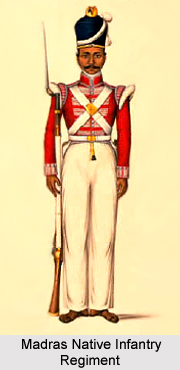 The 27th Madras Native Infantry was mainly an infantry regiment of the British East India Company. The army unit was incorporated as a part of the Madras Command. It was also a part of the Madras Native Infantry, which was under the Army of the Madras province, before the beginning of the Sepoy Mutiny of 1857. The Battalion remained in existence from the year 1798 to 1922 under the East India Company. The Madras Army was the armed forces of Madras Presidency and one of the three main Presidency Armies in British India. The Army of Madras Presidency was established with the purpose of protecting the commercial interests of the British East India Company. The British Presidency Armies were a part of the British East India Company until the Indian Rebellion, also known as the Great Revolt of 1857.
The 27th Madras Native Infantry was mainly an infantry regiment of the British East India Company. The army unit was incorporated as a part of the Madras Command. It was also a part of the Madras Native Infantry, which was under the Army of the Madras province, before the beginning of the Sepoy Mutiny of 1857. The Battalion remained in existence from the year 1798 to 1922 under the East India Company. The Madras Army was the armed forces of Madras Presidency and one of the three main Presidency Armies in British India. The Army of Madras Presidency was established with the purpose of protecting the commercial interests of the British East India Company. The British Presidency Armies were a part of the British East India Company until the Indian Rebellion, also known as the Great Revolt of 1857.
Later in the year 1903, the 3 major presidency armies were unified to develop the United British Indian Army. The 27th Madras Native Infantry was also known as the 87th Pioneers regiment.
History of 27th Madras Native Infantry
The 27th Madras Native Infantry was established in the year 1798 by the Honourable British East India Company as the 1st Battalion, 14th Madras Native Infantry regiment. The troops fought in the Third Anglo Maratha War and were actively involved in the Battle of Mahidpur. Subsequently the unit participated in various military campaigns and battles. They also participated in the Siege and the Capture of Lucknow during the Great Revolt in the year 1857. Later in 1885, the battalion was later stationed at Burma and participated in the Second Burmese War. The 87th Pioneers also provided military service during the First World War and guarded the North West Frontier from the invasions of the Afghan tribesmen.
Moreover the regiment deployed almost 1,400 personnel to other regiments as reinforcements. The regiment of the 27th Madras Native Infantry later took part in the Campaign of Mesopotamia.
Development of 27th Madras Native Infantry
After the First World War, the British Government of India renumbered and integrated the British Indian army. The several single battalion infantry regiments were merged to form multi battalion regiments. In 1922, the 27th Madras Native Infantry was re-designated as the 5th Battalion, 2nd Punjab Regiment. When the nation achieved independence from the rule of the British Empire in India in the year 1947, the country was divided into the Union of India and the Dominion of Pakistan with the Partition of India. The British Indian Army was divided among the 2 newly formed countries. The 27th Madras Native Infantry regiment was not disbanded and was re-assigned to the modern Indian Army.
Designations of 27th Madras Native Infantry
The regiment, initially known as the 1st Battalion, 14th Madras Native Infantry regiment of the British Indian Army, held a number of designations through out its existence during the restructuring of the army, like all the other regiments. These are listed as follows -
* 1st Battalion, 14th Madras Native Infantry in 1798
* 27th Madras Native Infantry in 1824
* 27th Madras Infantry in 1885
* 87th Punjabis in 1903
* 5th Battalion, 2nd Punjab Regiment in 1922



















